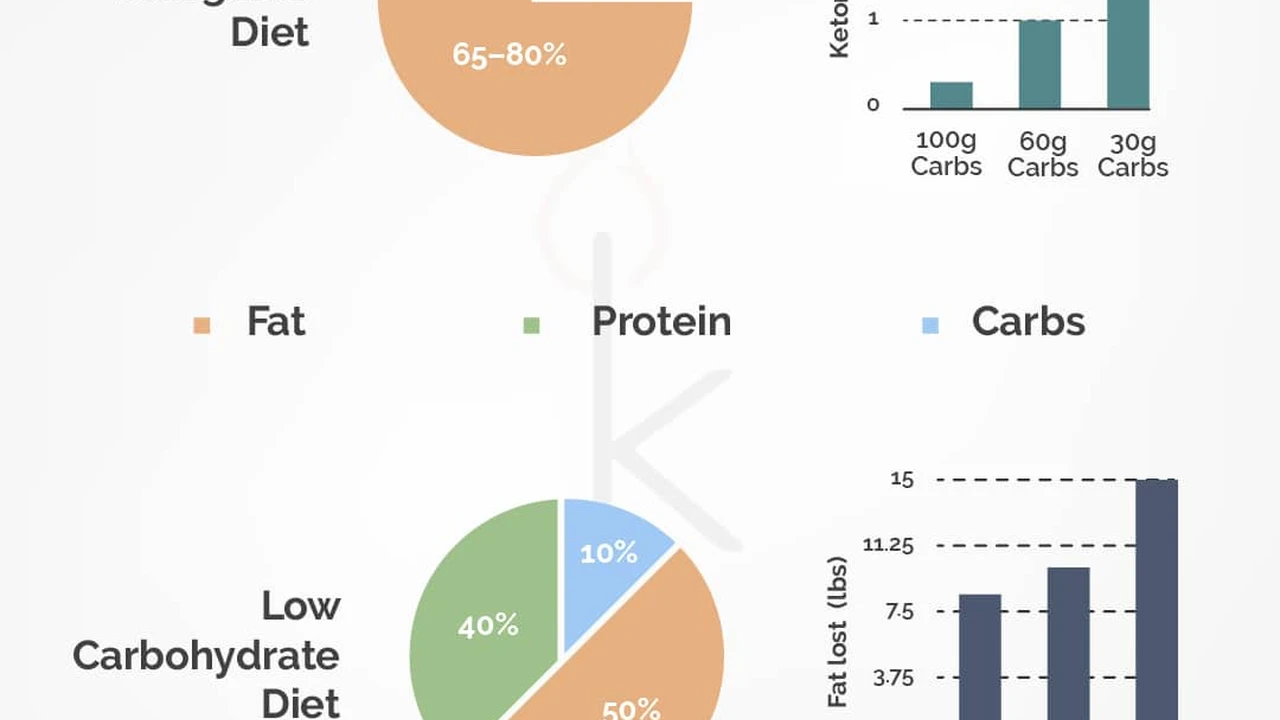Comparing Keto and Low Carb Seasonal Eating
Explore the differences between keto and low-carb diets adapted for seasonal eating. Find the best approach for your metabolic health.

Explore the differences between keto and low-carb diets adapted for seasonal eating. Find the best approach for your metabolic health.
Comparing Keto and Low Carb Seasonal Eating
Understanding the Core Principles of Keto and Low Carb Diets
When it comes to dietary approaches focused on carbohydrate restriction, two terms often come up: ketogenic (keto) and low-carb. While they share similarities, they are not interchangeable. Understanding their core principles is crucial before adapting them to seasonal eating.
What is a Ketogenic Diet? Keto Basics and Macronutrient Ratios
A ketogenic diet is a very low-carbohydrate, high-fat, and moderate-protein diet. The primary goal of keto is to induce a metabolic state called ketosis, where your body primarily burns fat for fuel instead of carbohydrates. This is achieved by drastically reducing carbohydrate intake, typically to 20-50 grams per day, depending on individual tolerance and activity levels. The macronutrient breakdown usually looks something like this: 70-75% of calories from fat, 20-25% from protein, and 5-10% from carbohydrates. This strict carbohydrate restriction forces the liver to convert fat into ketones, which then serve as an alternative energy source for the brain and body. Benefits often cited include weight loss, improved blood sugar control, increased energy, and enhanced cognitive function.
What is a Low Carb Diet? Low Carb Flexibility and Broader Ranges
A low-carb diet, on the other hand, is a broader term that encompasses any diet that restricts carbohydrate intake, but not necessarily to the extreme levels required for ketosis. There's no universally agreed-upon definition for 'low-carb,' but it generally means consuming fewer than 100-150 grams of carbohydrates per day. This allows for more flexibility in food choices compared to keto. While some low-carb diets might lead to mild ketosis, it's not their primary objective. The focus is more on reducing refined carbohydrates, sugars, and processed foods, and emphasizing whole, unprocessed foods. Benefits often include weight management, improved metabolic markers, and reduced cravings. The flexibility of a low-carb diet makes it easier to sustain for many individuals.
Adapting Keto and Low Carb for Seasonal Eating Benefits
Seasonal eating involves consuming foods that are naturally in season in your local area. This approach offers numerous benefits, including fresher produce, better taste, higher nutrient content, and often a lower environmental footprint. Integrating seasonal eating with keto or low-carb principles can enhance these benefits and provide a more sustainable and enjoyable dietary lifestyle.
Seasonal Produce for Keto Friendly Options
For a ketogenic diet, seasonal eating means focusing on low-carb vegetables and fruits that are in season. In spring, think asparagus, spinach, kale, and radishes. Summer brings zucchini, bell peppers, cucumbers, and berries (in moderation). Autumn offers Brussels sprouts, cauliflower, broccoli, and leafy greens. Winter provides hardy greens like collards, cabbage, and root vegetables like turnips (in limited quantities). Prioritizing these fresh, in-season options ensures you're getting nutrient-dense foods while staying within your carbohydrate limits. For example, instead of relying on frozen or imported produce, you can enjoy the peak flavor and nutritional value of locally grown, seasonal low-carb vegetables.
Seasonal Produce for Low Carb Flexibility
A low-carb diet offers more leeway with seasonal produce. While still emphasizing non-starchy vegetables, you can incorporate a wider variety of fruits and some starchy vegetables in moderation. Spring might include peas and new potatoes (in small portions). Summer allows for more generous servings of berries, melons, and even some corn. Autumn can feature squash, sweet potatoes, and apples. Winter offers a range of root vegetables and citrus fruits. This flexibility makes it easier to enjoy the bounty of each season without feeling overly restricted. For instance, a low-carb approach might allow for a small serving of seasonal sweet potato fries, whereas a strict keto diet would typically avoid them.
Practical Strategies for Seasonal Keto and Low Carb Meal Planning
Implementing seasonal eating into your keto or low-carb diet requires thoughtful meal planning. Here are some practical strategies to help you navigate the seasons.
Spring into Keto and Low Carb Freshness
Spring is a time of renewal, and your diet can reflect that. Focus on tender greens, fresh herbs, and early-season vegetables. For keto, think asparagus with hollandaise, spinach and mushroom omelets, or salads with fresh radishes and avocado. For low-carb, you can add a few snap peas to your stir-fry or enjoy a small portion of strawberries. Incorporate lean proteins like spring lamb or fresh fish. Look for local farmers' markets to find the freshest produce.
Summer Sizzle with Keto and Low Carb
Summer offers an abundance of vibrant, low-carb friendly produce. Grilling becomes a staple. For keto, enjoy grilled zucchini, bell peppers, and eggplant alongside fatty cuts of meat or fish. Berry smoothies (with low-carb sweeteners) can be a refreshing treat. For low-carb, you can have larger portions of berries, or even a small slice of watermelon. Hydration is key, so focus on water infused with cucumber and mint, or unsweetened iced tea.
Autumn Harvest for Keto and Low Carb Comfort
As temperatures drop, comfort foods come to mind. For keto, roasted Brussels sprouts, cauliflower mash, and hearty stews with plenty of non-starchy vegetables are excellent choices. Pumpkin seeds and nuts can be incorporated for healthy fats. For low-carb, you can enjoy small servings of roasted butternut squash or sweet potato. Warm, spiced beverages like unsweetened almond milk lattes with cinnamon can be comforting. Focus on root vegetables and cruciferous vegetables that are in season.
Winter Warmth with Keto and Low Carb Staples
Winter calls for warming, nutrient-dense foods. For keto, think rich bone broths, slow-cooked meats with leafy greens like collards or kale, and creamy cauliflower soups. Healthy fats from avocados and olive oil are essential. For low-carb, you can include small amounts of root vegetables like carrots or parsnips in your stews. Citrus fruits, while higher in carbs, can be enjoyed in moderation for their vitamin C content. Focus on hearty, slow-cooked meals that provide sustained energy.
Comparing Specific Products and Tools for Seasonal Keto and Low Carb
To successfully implement seasonal keto or low-carb eating, certain products and tools can be incredibly helpful. Here's a comparison of some popular options, including their uses, pros, cons, and approximate pricing.
Ketone Meters and Glucose Monitors for Biohacking
For those on a strict ketogenic diet, monitoring ketone levels is often desired to ensure you're in ketosis. Glucose monitors are also useful for understanding blood sugar responses to different foods.
- Keto-Mojo GK+ Blood Glucose & Ketone Meter: This is a highly popular and accurate device for measuring both blood glucose and ketones. It provides precise readings, which is crucial for fine-tuning your diet.
- Use Case: Daily monitoring for strict keto adherence, troubleshooting stalled weight loss, or understanding individual responses to specific foods.
- Pros: High accuracy, measures both glucose and ketones, easy to use.
- Cons: Test strips can be expensive, requires finger pricking.
- Approx. Price: Meter kit ~$50-$70, Test strips ~$30-$50 for 50 strips.
- Precision Xtra Blood Glucose and Ketone Monitoring System: Another reliable option, often used in clinical settings.
- Use Case: Similar to Keto-Mojo, for precise tracking of metabolic state.
- Pros: Very accurate, widely available.
- Cons: Test strips are costly, requires finger pricking.
- Approx. Price: Meter kit ~$40-$60, Test strips ~$35-$55 for 50 strips.
- Breath Ketone Meters (e.g., Ketonix, KetoScan Mini): These devices measure acetone in your breath, which is a byproduct of fat metabolism.
- Use Case: Non-invasive, convenient daily monitoring for general ketosis indication.
- Pros: No finger pricking, reusable, less ongoing cost than strips.
- Cons: Less precise than blood meters, can be affected by breath patterns, initial device cost is higher.
- Approx. Price: ~$100-$200.
Low Carb Sweeteners and Sugar Alternatives
Both keto and low-carb diets often utilize sugar alternatives to satisfy sweet cravings without spiking blood sugar. However, quality and type matter.
- Erythritol (e.g., Swerve, NOW Foods Erythritol): A sugar alcohol that is naturally found in some fruits. It has a mild sweetness and is generally well-tolerated.
- Use Case: Baking, sweetening beverages, general sugar replacement.
- Pros: Zero calories, zero net carbs, doesn't raise blood sugar, generally no digestive issues in moderate amounts.
- Cons: Can have a cooling sensation, less sweet than sugar (requires more).
- Approx. Price: ~$10-$20 per pound.
- Stevia (e.g., Truvia, SweetLeaf Stevia): A natural sweetener derived from the stevia plant. It's much sweeter than sugar, so a little goes a long way.
- Use Case: Beverages, small-batch baking, general sweetening.
- Pros: Zero calories, zero net carbs, very potent.
- Cons: Can have a bitter aftertaste for some, especially in larger quantities.
- Approx. Price: ~$5-$15 for small packets/liquid.
- Monk Fruit (e.g., Lakanto Monkfruit Sweetener, Whole Earth Sweetener Co.): Another natural sweetener derived from monk fruit. Often blended with erythritol to improve taste and texture.
- Use Case: Baking, cooking, general sugar replacement.
- Pros: Zero calories, zero net carbs, no aftertaste for most people, very sweet.
- Cons: Can be more expensive than other options.
- Approx. Price: ~$15-$25 per pound.
Healthy Fats for Keto and Low Carb Cooking
Fats are a cornerstone of both diets, especially keto. Choosing the right fats is essential for health and flavor.
- Avocado Oil (e.g., Chosen Foods Avocado Oil, Primal Kitchen Avocado Oil): A versatile oil with a high smoke point, making it suitable for high-heat cooking.
- Use Case: Frying, roasting, salad dressings, general cooking.
- Pros: High in monounsaturated fats, neutral flavor, high smoke point.
- Cons: Can be more expensive than other cooking oils.
- Approx. Price: ~$10-$20 for a 16.9 oz bottle.
- MCT Oil (e.g., Bulletproof Brain Octane Oil, NOW Foods MCT Oil): Medium-chain triglycerides are quickly absorbed and converted into ketones, making them popular for keto.
- Use Case: Adding to coffee (bulletproof coffee), smoothies, salad dressings (not for high-heat cooking).
- Pros: Rapid energy source, can boost ketone production, tasteless.
- Cons: Can cause digestive upset if consumed in large quantities, not suitable for high-heat cooking.
- Approx. Price: ~$20-$40 for a 32 oz bottle.
- Ghee (e.g., Fourth & Heart Ghee, Organic Valley Ghee): Clarified butter, which has had milk solids removed, making it suitable for those sensitive to dairy. High smoke point.
- Use Case: Sautéing, roasting, baking, spreading.
- Pros: Rich, buttery flavor, high smoke point, lactose and casein-free.
- Cons: More expensive than butter.
- Approx. Price: ~$10-$20 for a 13 oz jar.
Low Carb Flours and Baking Mixes
For those who enjoy baking, low-carb flour alternatives are essential.
- Almond Flour (e.g., Bob's Red Mill Almond Flour, Kirkland Signature Almond Flour): A popular gluten-free, low-carb flour made from ground almonds.
- Use Case: Baking cakes, cookies, muffins, bread, coating for frying.
- Pros: Good source of healthy fats and protein, low in carbs, good texture for baking.
- Cons: Can be expensive, not suitable for nut allergies.
- Approx. Price: ~$10-$15 per pound.
- Coconut Flour (e.g., Anthony's Organic Coconut Flour, Nutiva Organic Coconut Flour): Made from dried, defatted coconut meat. Highly absorbent.
- Use Case: Baking, thickening sauces, small amounts in recipes due to high absorbency.
- Pros: Very low in carbs, high in fiber, gluten-free.
- Cons: Very absorbent, requires more liquid in recipes, distinct coconut flavor (though mild in baking).
- Approx. Price: ~$5-$10 per pound.
- Low Carb Baking Mixes (e.g., King Arthur Keto Wheat Flour Blend, Birch Benders Keto Pancake & Waffle Mix): Pre-mixed blends designed for convenience.
- Use Case: Quick and easy baking of specific items like pancakes, bread, or pizza crusts.
- Pros: Convenient, consistent results, saves time.
- Cons: Can be more expensive than buying individual flours, ingredients may vary.
- Approx. Price: ~$8-$15 per bag/box.
Potential Challenges and How to Overcome Them
While both keto and low-carb diets offer benefits, they also come with potential challenges, especially when combined with seasonal eating. Awareness and preparation can help you overcome these hurdles.
Navigating Social Gatherings and Seasonal Events
Seasonal holidays and social gatherings often revolve around food, which can be challenging for those on restrictive diets. Plan ahead by offering to bring a keto or low-carb friendly dish, or by eating a substantial meal before you go. Focus on protein and healthy fats, and be mindful of hidden carbs in sauces and dressings. Don't be afraid to politely decline foods that don't fit your plan. Remember, it's about progress, not perfection.
Ensuring Nutrient Adequacy Across Seasons
Restricting food groups can sometimes lead to nutrient deficiencies. With seasonal eating, you're already getting fresher, more nutrient-dense produce. However, ensure you're consuming a wide variety of low-carb vegetables and healthy fats. Consider supplementing with electrolytes (especially on keto) to prevent the 'keto flu,' and discuss any concerns about nutrient intake with a healthcare professional or registered dietitian. For example, in winter, when fresh produce might be less varied, focus on fermented foods for gut health and consider vitamin D supplementation.
Dealing with Cravings and Adherence
Cravings can be a significant hurdle, especially when transitioning to a lower-carb lifestyle. Ensure you're eating enough fat and protein to feel satiated. Experiment with low-carb friendly recipes that mimic your favorite high-carb comfort foods. For example, cauliflower rice instead of regular rice, or zucchini noodles instead of pasta. Seasonal fruits can be a great way to satisfy sweet cravings on a low-carb diet, while keto dieters might opt for berries in moderation or sugar-free desserts made with approved sweeteners. Consistency is key, and allowing for occasional, planned indulgences on a low-carb diet can sometimes aid long-term adherence.
Which Approach is Best for You Keto or Low Carb Seasonal Eating?
The choice between keto and low-carb, especially when incorporating seasonal eating, depends on your individual goals, health status, and lifestyle. There's no one-size-fits-all answer.
Consider Your Health Goals and Metabolic State
If your primary goal is rapid weight loss, significant blood sugar control (e.g., for type 2 diabetes management), or managing certain neurological conditions (like epilepsy), a strict ketogenic diet might be more effective. However, if you're looking for sustainable weight management, improved energy levels, and better overall metabolic health without the strictness of ketosis, a more flexible low-carb approach might be more suitable. Consult with a healthcare provider to determine the best approach for your specific health needs.
Evaluate Your Lifestyle and Sustainability
A ketogenic diet requires significant commitment and careful tracking of macronutrients. It might be challenging to maintain long-term, especially when traveling or dining out. A low-carb diet offers more flexibility, making it easier to integrate into a busy lifestyle and sustain over extended periods. Consider which approach you can realistically stick to consistently, as consistency is more important than short-term perfection.
Experiment and Listen to Your Body
The best way to determine which approach works for you is to experiment. Try a strict keto diet for a few weeks and see how your body responds. Then, try a more moderate low-carb approach. Pay attention to your energy levels, mood, digestion, and overall well-being. Some people thrive on strict keto, while others feel better with a bit more carbohydrate flexibility. Seasonal eating can naturally guide your choices, encouraging variety and nutrient density regardless of whether you choose keto or low-carb. Ultimately, the goal is to find a sustainable and enjoyable way of eating that supports your metabolic health and overall well-being throughout the year.
:max_bytes(150000):strip_icc()/277019-baked-pork-chops-with-cream-of-mushroom-soup-DDMFS-beauty-4x3-BG-7505-5762b731cf30447d9cbbbbbf387beafa.jpg)






